| The Powerful Medium Tank TG |
|---|
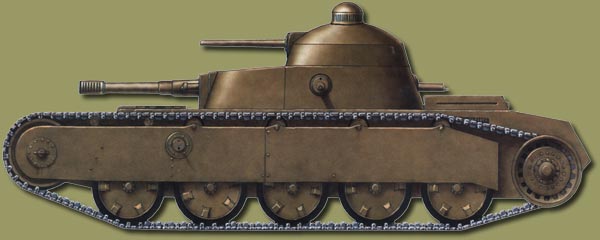
| Note: All Russian terms and abbreviations marked as red italic are described in the Glossary. |
Led by German Engineer, Edward Grote, work began on a heavily armored, medium-weight tank as an alternative to the maneuverable T-24, in 1930. Members of the Soviet Mission, after visiting Germany in late 1929/early 1930, invited Grote to the U.S.S.R. After his arrival, Grote began his work at the Design Office AVO-5, within the Aviation Engine Department of the "Bolshevik" Factory. Here, in 1930, steps were being taken to manufacture the experimental, TG Tank (Tank Grote).
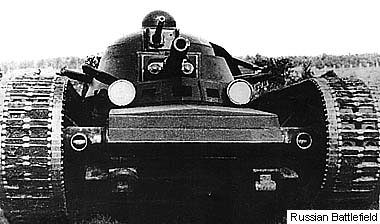 The Powerful Medium Tank TG |
The TG was expected to have a combat-ready weight of 20 tons, a top speed of 40 km/h, a cruising speed of 25 km/h, and 15 mm, 20 mm, 30 mm in armor. The 240 hp (176.5 kw), air-cooled, carburetor engine for the TG Tank, was specifically designed by Grote. The armament comprised of one 76 mm-cannon, one 37 mm- cannon and 4 or 5 machineguns. OGPU and NKVM were instructed to proceed with the testing and completion of the TG Tank. The assignment was given priority, as one of the most important tasks within the category of experimental tanks for 1931. The first series of 50-75 tanks were planned to familiarize the overall production process. Prior to completion, preparatory work and trials for the experimental TG Tank were also planned. Therefore, manufacture of the T-24 was continued as a temporary measure. After the completion of 80 T-24's, the production line was closed and the mass production of TG's was planned in the KhPZ. 2,000 TG Tanks were projected for manufacture in 1932.
S.A. Ginzgurg, head of Design Bureau #3 of the VOAO, visited Great Britain at the end of 1930. In the course of discussions with British Engineers, he learned of the new, 16-ton Tank, A-6 (Mk-III). Also in the discussions at the Vickers' Factory, he learned of the tank's layout and the technical and tactical parameters. Ginzburg presented a detailed report on the new tank upon arrival to the U.S.S.R., which caught the attention of the Red Army High Command. Moreover, the Mark III was the closest to complying with the requirements of, accepted "System of Tank-Tractor-Motorcar-Weapon-Armament of the RKKA," and was superior to the TG Tank.
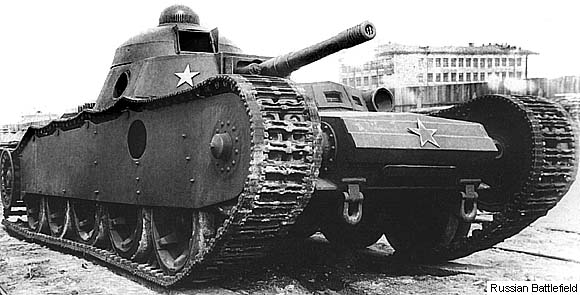
Meantime, the "Bolshevik" Factory was working on the prototype of the TG Tank. Resolution No. 2 of the Defense Committee, from 9/2/31, set up the project management. Medved', (OGPU), was General Administrative Manager, K.K. Sirken was Head of Design Bureau, N.V. Barykov was Deputy for Manufacturing, and A. Vorobiev, (UMM) was Deputy for Design. The experimental TG Tank was completed in the summer of 1931. The tank featured three-level armament positions, elongated hull to 7.5 meters, turret located in the rear, a high box section located under the turret, a running gear with high tracks that was covered by an armored skirt, and a small observation turret with a periscope and a hydraulically assisted transmission controls.
The tank was armed with a 76.2 mm-Grote-Syatchentov-Cannon, with a slit muzzle brake with a wedge type breach and thee ball-mounted Maxim-Machineguns, all set in a box section under the turret for a second level of armament. The cannon could be turned ±10° in a horizontal plane and elevated from -8° to +12° in a vertical plane. Two DT-Machineguns, in ball-mountings were fixed in side plates of the driving compartment, which constituted the first level of armament. Both guns had a limited arc of fire.
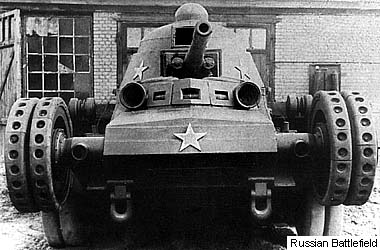 TG on wheels. VAMM. 1931. |
The third level of armament comprised of a 37 mm, PS-1 Cannon in a rotating turret located on top of the box section. The cannon could fire at ground and low flying targets at an elevation of -12° to +30°. Ammunition consisted of fifty 76.2 mm shells, eighty 37 mm shells and 7,000 rounds for the machineguns.
The five-man crew consisted of: a driver, commander, (also responsible for the 37 mm-cannon), machine gunner, and a gunner and loader, (76.2 mm-cannon). The driver had three vision panels with slits for field observation while driving. A periscope was mounted on top of the turret for the tank commander. On top of the driving compartment, (2) oval hatches provided access to the tank.
The light armor consisted of 8, 13, 16, 20 and 30 mm, rolled, steel-plates, jointed together by welding. In the rear section of the hull, a M-6 carburetor-engine, throttled to produce 250 hp, (184 kw) powered the TG. (The engine designed by Grote was not ready at the time of the trials). Transmission gears included a multi-disk, main dry-friction clutch, a six-speed gearbox with V shape teeth, and a full reverse mechanism, (2) side clutches, and (2), one-step reduction gears housed in the front wheels.
The suspension had individual springs (i.e., Christie Tank). The running gear was made of (2) idlers, (10) large-diameter, road wheels with 'Elastic' lining, (6) support wheels, (four of medium diameter with external shock absorbers and two of smaller diameter), and driving sprockets located at the rear which are locked with tracks by a chain. All of the road wheels were equipped with brakes in the event that tracks broke or fell off.
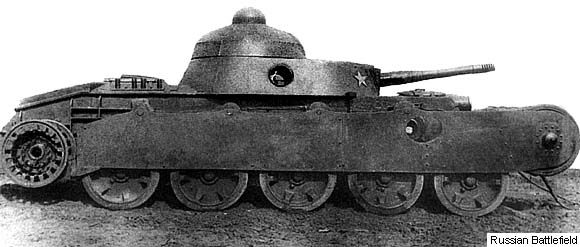
Road tests took place from June 27 to October 1, 1931. The 25-ton tank had a top speed of 35 km/h on paved roads and a range of 165 km in open terrain. The transmission and traction systems, along with the steering gears proved unreliable during tests. Representatives of UMM and VOAO formed a committee to study the test results. Upon conclusion, it was agreed to designate the tank as an experimental type. Further testing of all new features was required. Despite rectifying the faults that were found during testing, it was decided that the TG Tank would not be introduced to production. Further work on the TG Tank was suspended and the services of Edward Grote were no longer required. Soon after, in August 1933, Grote was requested to leave the U.S.S.R. Despite the fact that the TG did not enter mass production, Soviet Engineers gained substantial experience in the design of medium weight tanks.
| REFERENCES: Specification of Soviet tanks Specifications of Soviet tank guns |
Translated by:
Krzysztof Pawlowski Proof-reader: Scott Y. Barbo Sources: M.Pavlov, I.Pavlov, I.Zheltov "Sovetskie Srednie Tanki Dovoennogo Perioda" Armada #7, 2000: M.Kolomiets, I.Moshanskiy "Mnogobashennie Tanki RKKA" Frontovaya Illustratsiya #5, 2000; Cover picture by A.Aksenov. |